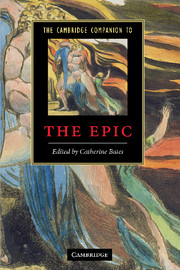Book contents
- Frontmatter
- 1 The Epic of Gilgamesh
- 2 Greek epic
- 3 Roman epic
- 4 Heroic epic poetry in the Middle Ages
- 5 Dante and the epic of transcendence
- 6 Italian Renaissance epic
- 7 Camões’s Os Lusíadas: the first modern epic
- 8 The Faerie Queene: Britain’s national monument
- 9 The seventeenth-century Protestant English epic
- 10 Mock-heroic and English poetry
- 11 Romantic re-appropriations of the epic
- 12 Ezra Pound, T.S. Eliot, and the modern epic
- 13 Derek Walcott’s Omeros
- 14 Epic in translation
- Guide to further reading
- Index
6 - Italian Renaissance epic
Published online by Cambridge University Press: 28 May 2010
- Frontmatter
- 1 The Epic of Gilgamesh
- 2 Greek epic
- 3 Roman epic
- 4 Heroic epic poetry in the Middle Ages
- 5 Dante and the epic of transcendence
- 6 Italian Renaissance epic
- 7 Camões’s Os Lusíadas: the first modern epic
- 8 The Faerie Queene: Britain’s national monument
- 9 The seventeenth-century Protestant English epic
- 10 Mock-heroic and English poetry
- 11 Romantic re-appropriations of the epic
- 12 Ezra Pound, T.S. Eliot, and the modern epic
- 13 Derek Walcott’s Omeros
- 14 Epic in translation
- Guide to further reading
- Index
Summary
In recent years the sources and conceptual foundations of the epic produced during the Italian Renaissance have been documented in great detail. We have been confirmed in the knowledge that this literary genre developed and was decisively shaped by the relatively small but cohesive city of Ferrara, and that it was promoted by its rulers, the dukes of the House of Este. The three major practitioners of the genre, Matteo Maria Boiardo (1441-94), Ludovico Ariosto (1474-1533), and to a lesser extent Torquato Tasso (1544-95), lived in that court and knew intimately the twists and turns of the Este genealogical history. They wrote their epics - respectively the Orlando Innamorato, the Orlando Furioso, and the Gerusalemme Liberata - in that courtly context and were immersed in its mythology and rituals. By living in close contact with the intellectual-political events of the court, they were bound to take part, as they did, in its lively cultural activities and innovations. These ranged from the theatre to humanistic theories of education, to steady speculations over ethical systems that more often than not slid into monotonous restatements of the nature of virtue and values, to elaborate artistic productions, such as the 'Sala dei Mesi' by Francesco del Cossa (1436-78) commissioned by Borso d'Este for the Schifanoia Palace. These activities signal the Estes' efforts to make their city emerge from the grips of its provincialism. Both the role of the university and the presence of these intellectuals in Ferrara cannot be treated as random episodes in the court's cultural life.
- Type
- Chapter
- Information
- The Cambridge Companion to the Epic , pp. 93 - 118Publisher: Cambridge University PressPrint publication year: 2010



